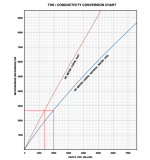- Sep 9, 2024
- 3
- Pool Size
- 35000
- Surface
- Fiberglass
- Chlorine
- Salt Water Generator
Hi all, we've had our new pool for a few months now and it's been going great, largely due to the great advice and guidance found on TFP (thanks!). I've been using the PoolMath app to keep the water balanced but wanted to check whether I should be using a specific TDS value rather than just salinity due to the type of salt we use. We've been using Zodiac Mineral Elements, as this is what our installer provided. Its composition is 30% magnesium and 70% sodium. Our current TDS is 2000 ppm and salinity is 1400 ppm. Note our SWG is an ultra-low salt system.
I know the PoolMath app must derive TDS somehow but there are other apps (e.g. Orenda) that accept actual TDS as input and yield quite different results for SI with all other parameters equal. So, my question is what should I be using to get the most accurate CSI?
Thanks in advance.
Current readings below for reference.
FC: 3.2
CC: 0
pH: 7.6
TA: 90
CH: 275
CYA: 50
TDS: 2000
Salinity: 1400
Temp: 26°C
I know the PoolMath app must derive TDS somehow but there are other apps (e.g. Orenda) that accept actual TDS as input and yield quite different results for SI with all other parameters equal. So, my question is what should I be using to get the most accurate CSI?
Thanks in advance.
Current readings below for reference.
FC: 3.2
CC: 0
pH: 7.6
TA: 90
CH: 275
CYA: 50
TDS: 2000
Salinity: 1400
Temp: 26°C




